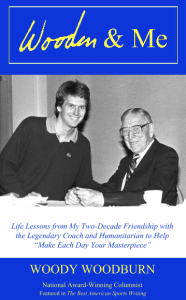 Woody’s highly anticipated new book “STRAWBERRIES IN WINTERTIME: Essays on Life, Love, and Laughter” is NOW available! Order your signed copy HERE!
Woody’s highly anticipated new book “STRAWBERRIES IN WINTERTIME: Essays on Life, Love, and Laughter” is NOW available! Order your signed copy HERE!
* * *
Don’t Like This Writer? You’re Fired!
Editors note: Woody Woodburn is taking the day off. He has asked publicist “John Miller,” who reportedly worked for Donald Trump in 1991, to fill in today.
*
The Ventura Star will be great again next Saturday because Woody Woodburn will be back with his column. Believe me, Mr. Woodburn is a great writer. Some people, many people, tell me he’s a very, very, very great writer.
Mr. Woodburn has all the best words. Long words, short words. Four-letter words and ten-letter words. You pick a number of letters, and he has a tremendous word.
A lot of people, smart people, people who read books, and I mean read a lot of books, thick books with many, many, pages, these really, really smart people tell me even Papa Hemingway was not as great a writer as Big Daddy Woody.
These same people, again I’m talking the smartest people, tell me Mr. Woodburn not only writes the best words, he writes unbelievable sentences and fantastic paragraphs. That’s the truth.
Think of the greatest columnists ever: Jim Murray, Red Smith, Ernie Pyle, Dear Abby. They couldn’t carry The Woodman’s laptop. Believe me.
What about the Ventura Star’s other columnists, you ask? Well, Colleen Cason, I’ve seen her type at her keyboard and she’s low-energy. Without three cups of coffee and a Red Bull she’s a total disaster.
Bill Nash’s columns are 10 percent shorter than Mr. Woodburn’s columns so obviously they are 10 percent worse.
Rhiannon Potkey and Jim Carlisle? Sports is called the newspaper toy department for a reason. That makes them Toys R Us writers.
And I’m not even going to mention Pa Ventura. But other people tell me Pa is really, really not a talented columnist. Pa-thetic. A real lightweight. Frankly, he’s a nasty guy.
Nobody, believe me nobody, has more respect for women readers than Mr. Woodburn. Women readers love him. And I’m talking beautiful women readers. Gorgeous women. Miss USA reads Mr. Woodburn’s columns, that’s the truth.
When you see the name “Woodburn” splashed above a column, you know it’s going to be classy and flashy and the best in the world. And Mr. Woodburn doesn’t just write columns – his name is on books, too.
Of all the books written in history, and I’m talking the greatest books ever, only The Good Book (The Bible) and The Great Book (“The Art of the Deal”) are better than “Wooden & Me” and “Strawberries in Wintertime.” And Mr. Woodburn’s next book, whatever it is, will be amazing. Believe me, absolutely amazing!
When you talk about writers, not just newspaper writers but writers of books, Mr. Woodburn is Mark Twain, John Steinbeck, Ernest Hemingway and J.K. Rowling rolled into one. Mr. Woodburn is huuuge like Shakespeare.
Speaking of huuuge, Mr. Woodburn’s Fitbit numbers make an Olympic marathoner envious. He also surfs the biggest waves, skis the tallest mountains and is more interesting than The Most Interesting Man in the World.
But back to writing. Mr. Woodburn leads all the Amazon.com polls. He has huuuge numbers, believe me. Any best-seller’s list that doesn’t rank Mr. Woodburn’s books at the very top is rigged. Totally corrupt.
Let’s be honest, a lot of writers are really not very smart people. But Mr. Woodburn’s IQ is high, SpaceX rocket-ship high, high like Einstein’s IQ, but with words instead of math numbers. This allows Mr. Woodburn to write some of the best words and sentences ever.
Mr. Woodburn’s energy is also high. He types lightening fast, believe me. You wouldn’t believe how fast he types. He has big hands yet his fingers dance on the keyboard like Fred Astaire.
I have heard from lots of people, you really wouldn’t even believe how many people, who say reading is dead. Reading’s best times are in the past, they say. But they are as stupid as our China trade deals. The Woodster is making reading great again.
Next Saturday’s column by Mr. Woodburn is going to be amazing. Phenomenal. Amazingly phenomenal. Believe me. Check it out and you won’t believe how very, very tremendous it is.
* * *
Woody Woodburn writes a weekly column for The Ventura County Star and can be contacted at WoodyWriter@gmail.com.
 Check out my new memoir WOODEN & ME: Life Lessons from My Two-Decade Friendship with the Legendary Coach and Humanitarian to Help “Make Each Day Your Masterpiece”
Check out my new memoir WOODEN & ME: Life Lessons from My Two-Decade Friendship with the Legendary Coach and Humanitarian to Help “Make Each Day Your Masterpiece”
- Personalized signed copies are available at WoodyWoodburn.com
- Unsigned paperbacks or Kindle ebook can be purchased here at Amazon




